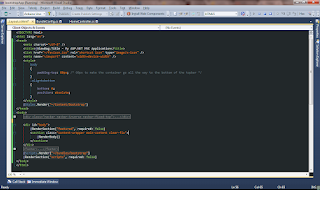I decided to try a new thing on the weekend. I went to Startup Weekend. An event where anyone can pitch an idea and work on for the chance of winning funding and other perks and fun. The event took place in
Packard Place in downtown Charlotte. I did not have any ambitions of starting my own business (yet!) but I wanted to get exposed to the process in case I want to. I also wanted to improve my programming skills. The weekend was quite an adventure that I learned a lot from so I am going to talk about what happened and follow up with what I learned.
Day one - The Pitch:
Everyone with an idea were given a minute to pitch. I decided to go for it as I don't get a chance to practice my public speaking skills every day so I went for it. After an adrenaline rush that lasted for over 30 minutes, I pitched my idea and I did not know how to explain it and it got lost in the sea of pitches. It was really bad.
After voting for the top pitches, We had to join a team that we are interested in working with. It was tricky given that I had no interest in any of the ideas so I chose a team that needed a web developer and had other developers that I could learn from. We did not win and I really don't regret not choosing another team. I came to the event to sharpen my skills and I think I worked on a really challenging product.
Day 2: The head down coding phase:
Now that the plan is set, we divided our team to handle the development, marketing, bushiness planning and research. I decided to handle the web development given that we already had 3 developers in the team who handled the Android app and the back end of the server.. ... I was able to pull a quick web layout thanks to bootstrap and Google maps. I used Google charts for the first time and it was really easy to use.
Day 3: The catching up:
The last day. We did not code freeze and it felt as if we were moving the last pieces of a jinga game. I finished up my web development and we were really impressed by how fast we finished the product.
The presentation went better than what I expected. The marketing and project management guys were able to research the product and pulled a
really nice presentation.
We did not win the contest ... But I learned a lot and met amazing people.

Lessons learned:
- I am not the only one with a "great" idea. Over half of the crowed came up to pitch and I actually liked a lot of the ideas that were not selected.
- I should practice my pitch. I failed at communicating my idea to the public and this is what they thought it was (reminder: it was about creating a bucket list for friends)
- I should be passionate about my pitch and I should show it.
- Focus on solving problems
- Prove a track record of what I done before to support my pitch.
- Think about which team to join and what project I could add the most value to.
- Bring in my business cards. I regret not marketing myself. Especially given the melting pot nature of talented people that I could network with.
- Bring in more of my friends. Knowing people makes it easier to jump into conversations and meet others.
- Take breaks and stay healthy. I think I might bring some board games to play with the team while taking breaks.
- Know my technologies and have suggestions for common solutions (web hosting, layouts, social marketing).
- Learn about technologies that are common among other start ups (Javascript, Ruby, mobile development, facebook Graph API).
- Read the rules... yeah.
Great quotes I heard (paraphrasing for some of them):
"Your customers will not move away from the bad process they are following because it works. You have to make your product a 100 times better before they will adopt it." - Tim Cheadle
"The biggest mistake you could make in start up weekend is to actually work on implementing your product"
List of skills and technologies I got exposed to:
Bootstrap: I used it before but I never created a full project with it. It is a great way to prototype websites. There are a lot of great templates and themes ready to use.
Google Charts: a great way to charts. We used it to plot a pie graph of the categories and a Bar graph for the spending. We ran into an API key issue but we fixed it.
Google Maps API: Used to show multiple transaction locations.
Android Geolocation: I had to get the coordination to plot them on the map. Google resources were really helpful.
prezi: A great presentation tool.
















